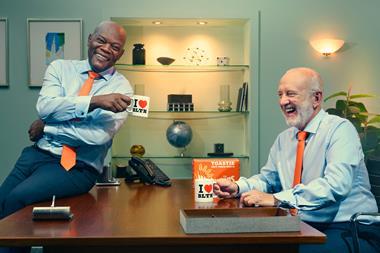Can breakfast sandwiches shed their greasy image in favour of a more wholesome one?
The term ‘breakfast sandwich’ likely conjures up images of a greasy hangover-curing bacon butty. But as breakfast on-the-go becomes increasingly common – the number of visits to food-to-go outlets at breakfast are up 5.8% year-on-year, according to analyst MCA – could the breakfast sarnie be given a nutritional boost?
“For almost a quarter (22%) of consumers, health is a main consideration when choosing breakfast, and we’re seeing different ‘grab-and-go’ options beyond the classic bacon sarnie,” explains Stéphanie Brillouet, marketing director – northern Europe & North America, Délifrance UK. “This demand for healthy yet convenient breakfast foods has encouraged retailers to provide filling options such as spinach, egg, mushrooms and avocado.”
However, consumers are faced with a barrage of often contradictory information when it comes to fats, sugar, calories and nutrition – what one person considers healthy, another might not.
Breakfast wraps have arguably gained favour from the perceived health benefits of wraps compared with bread.
But a closer look reveals the Ultimate Breakfast Wrap from McDonald’s boasts 605 calories and 31g of fat while the Sausage & Egg McMuffin has 430 calories and 24g of fat per serving.
The good news is things don’t have to change drastically to make them healthier. Breakfast burritos and wraps, for example, have already gained a following in the meal prep community as some look for protein-heavy ways to kick off their day.
That’s where customisation comes in. Bridor’s commercial director UK, Erwan Inizan, encourages retail bakery businesses to think beyond the bap and change up the carrier as well as fillings.
“Consumers’ growing knowledge of the health benefits of ancient grains, seeds and sourdough is increasing demand for better-for-you breads,” he says. “As well as providing a high source of fibre, we’ve developed recipes that incorporate seeds and nutrient-rich ancient grains such as millet, which has a high magnesium content, and sunflower seeds, which are an excellent source of vitamins E and B1.”
Délifrance research found 47% of people see bread-based dishes, such as sandwiches, as an everyday breakfast.
“As the meal’s base element, it’s vital to develop bread doughs that boost the overall nutritional content of the meal,” adds Brillouet, pointing to Délifrance’s Feel Good range of bread that combines flours such as spelt with inclusions such as seeds. “You can also develop flavours that are specifically paired with healthy fillings, creating sandwiches not only packed with nutrients but also delicious in taste.”
Kefir could provide another on-trend boost, particularly with the burgeoning interest in gut health.
“Kefir has a long tradition as an ingredient in bread, pancakes and scones in Eastern Europe and Scandinavia, bringing a slight sour note to these,” believes Anita Winther, food and drink analyst at Mintel.
She also notes opportunities in American-style frittata breakfast sandwiches that combine egg with meat, vegetables and/or cheese and bread, tapping the protein trend.
Or perhaps jianbing – a Chinese street food comprising savoury crisp-fried crêpes made from wheat mung bean flour with egg spread over the surface and fillings such as chicken, sausage and spring onion.
“It’s about developing bakery products that allow greater creativity,” adds Inizan.
That creativity could see breakfast sandwiches become synonymous with a cracking way to start the day.
A not so healthy start to the day
Health may be important at breakfast, but it doesn’t reign supreme all week long.
“Research has shown that breakfast consumers are as interested in purchasing something indulgent and filling as something healthy. This
ratio swings in favour of indulgence as the week goes along,” says Hannah Morter, marketing manager, customer insight & category management, Country Choice.
Food-to-go retailers are more than happy to oblige at the start of the day. Take the belly-busting full English in a loaf of bread from Bridgend’s Rolling Rolls. It contains four sausages, four rashers of bacon, four hash browns and beans for £10.
Over the pond, Eggslut is making waves in LA with its provocative name and breakfast sandwiches, focusing on high-quality ingredients. The Fairfax, for example, features cage-free soft scrambled eggs and chives, Cheddar cheese, caramelised onions and sriracha mayo in a warm brioche bun.
Some see it as a matter of pride to post their spectacular weekend brunch on social media – one of the key drivers behind these creations. The hashtag #brunch has more than 21.4 million posts on Instagram.
“Social media is driving demand for breakfast foods that have the wow factor, both as a means for people to attract likes and followers and as a source of inspiration,” says Anita Winther, food and drink analyst at Mintel. “While, on the one hand, this has driven demand for healthy options… it will also be driving demand for extreme and dirty options that have the shock factor and are visually impactful.”
The breakfast bagel boom
Bagels are winning when it comes to out-of-home breakfasts. The latest data from analyst MCA shows they were bought on more than 50 million occasions between July and September 2018.
“Bagels have been one of the fastest growing sandwich carriers on UK menus,” explains Philippa Knight, marketing manager – out of home, New York Bakery Co.
“They also consistently feature in the top three breakfast carriers out of home.”
Their growth was partly driven by McDonald’s, which accounts for 35% of all breakfast bagel visits. But, Knight believes they could work for other retailers
as well.
“Filled bagels hold well in hot cabinets so time-poor workers can grab them and go,” she says. “Their soft yet chewy texture can withstand hot fillings and sauces without getting too soggy – this usually being the downfall of traditional breakfast sandwiches made with sliced bread or baps.”





























No comments yet